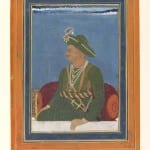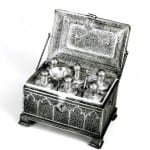The attar casket of Tipu Sultan
by Sarah Longair and Cam Sharp-Jones
Please note that this case study was first published on blogs.ucl.ac.uk/eicah in May 2013. The case study was last checked by the project team on 19 August 2014.
For citation advice, visit ‘Using the website’.
This intricately-decorated filigree casket is currently on display in the Addis Gallery of Islamic Art, located by the north entrance of the British Museum. Inside are six small bottles, a ladle and a funnel which bears a minute Persian inscription on the rim. Two documents written by one-time owners of the casket – one an undated letter, the other an incomplete note – give tantalising and fragmentary references to the casket’s provenance from the palace of Tipu Sultan (c.1750-1799) in Seringapatam (present-day Sriringapatna).[1] To read the documents, click here. These various pieces of material and documentary evidence allow us to track how the casket changed hands several times before its donation by Col. Henry Fraser to the Museum in 1904.
Many aspects of this object and its history piqued our interest: the enduring significance of Tipu Sultan, the particular attention paid by family members to transfer the casket between generations both in India and England as well as how material culture represented the legacy of East India Company family histories. This last aspect particularly reflects other family case studies in The East India Company at Home project.
The Persian inscription believed by the Frasers to refer to Hyder ‘Ali[2], Tipu Sultan’s father (c.1722-1782) brought our attention to how this object might represent collections and connoisseurship as a means of establishing dynastic legitimacy not only by East India Company families, but also within the court of Mysore.[3] Furthermore its placement in the Islamic gallery alongside objects related to Mughal India prompted questions about the interpretation and representation of imperial stories within the British Museum.
 The casket’s origins in eighteenth-century India
The casket’s origins in eighteenth-century India
Most likely made in the eighteenth century, the casket is a combination of both European and Indian motifs and designs. The shape of the casket is typical of European filigree and silver work and is also seen in Mughal examples, whilst the scrolling decoration is common to Indian-made articles of this type. By including a close study of the casket, this section of the case study reveals both its making and its early owners.
 Material culture from Seringapatam
Material culture from Seringapatam
How did objects belonging to Tipu Sultan enter British collections? What other objects were seized at this time? This section of the case study explores the objects that the British collected during the battle of Seringapatam and the implications of their passage to Britain.
 The Fraser family
The Fraser family
The casket was donated to the British Museum by Col. Henry Fraser in 1904 and the references in the letters allow us to trace its journey from Seringapatam to the Museum via various members of the Fraser family. This section of the case study examines the movement of this object through the different branches of the family to tracking its elaborate journey into the galleries on Great Russell Street.
 The casket in the British Museum
The casket in the British Museum
When it arrived in the British Museum, where was the casket placed? How was it interpreted then and now? This section of the case study explores the casket as a museum object and examines the meanings it now holds.
 Conclusion: shifting meanings
Conclusion: shifting meanings
Recognising the multiple facets of a single object, and the shifting meaning and value associated with it in different continents and contexts, provides a view into cultural encounters and appropriation in India and Britain.
To read the case study in PDF format, click here.
Acknowledgements
The text and research for this case study were primarily authored by Sarah Longair (Education Manager, Department of Learning, Volunteers and Audiences, British Museum) and Cam Sharp-Jones (Project Curator – Politics, Ritual and Religion in South Asia, British Museum).
The authors would like to thank Margot Finn, Kate Smith, Helen Clifford, Richard Blurton, Ladan Akbarnia, Sarah Choy, Vesta Curtis and Paramdip Khera for their advice and assistance in researching this case study.
[1]http://www.britishmuseum.org/research/search_the_collection_database/search_object_details.aspx?objectid=249650&partid=1&searchText=1904%2c1006.1.a&fromADBC=ad&toADBC=ad&numpages=10&orig=%2fresearch%2fsearch_the_collection_database.aspx¤tPage=1 Accessed 10 May 2013. The casket’s museum number is British Museum 1904, 1006.1a-i.
[2] Accepted spellings include ‘Haidar’, ‘Haider’, ‘Hayday’ and ‘Hayder’. For consistency ‘Hyder’ will be used as on the letter attached to the casket.
[3] Maya Jasanoff, Edge of Empire: Conquest and Collecting in the East 1750 – 1850 (London: Fourth Estate, 2005), p. 184.
